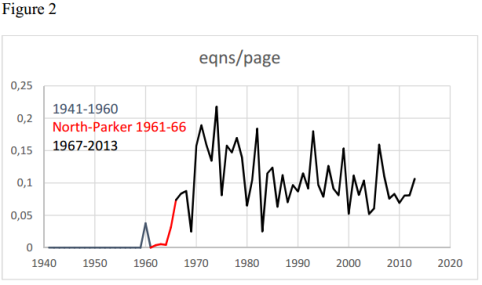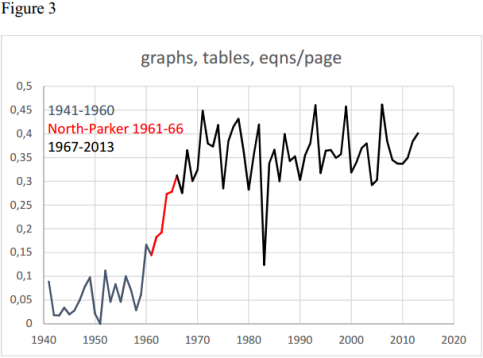A Cliometric Counterfactual: What if There Had Been Neither Fogel nor North?
Claude Diebolt (Strasbourg University) and Michael Haupert (University of Wisconsin – La Crosse)
Abstract – 1993 Nobel laureates Robert Fogel and Douglass North were pioneers in the “new” economic history, or cliometrics. Their impact on the economic history discipline is great, though not without its critics. In this essay, we use both the “old” narrative form of economic history, and the “new” cliometric form, to analyze the impact each had on the evolution of economic history.
URL: http://d.repec.org/n?u=RePEc:afc:wpaper:05-17&r=his
Circulated by nep-his on: 2017-02-19
Revised by Thales Zamberlan Pereira (São Paulo)
Douglass North and Robert Fogel’s contribution to the rise of the “new” economic history is well known, but Diebolt and Haupert’s paper adds a quantitative twist to their roles as active supporters of cliometrics when there was still resistance to apply new methods to the study of the past. Economic theory and formal modeling marked the division between the “old” and the “new” economic historians in the 1960s, and Diebolt and Haupert use two metrics to track the transformation in the field: 1) the increased use of graphs, tables, and especially equations during North’s period as editor (along with William Parker) of the Journal of Economic History between 1961 and 1966; 2) the citation of Fogel’s railroad work, to measure the impact of his innovations in economic history methodology.
Before showing their results about the positive influence of North and Fogel on quantitative economic history, the authors present a brief history of cliometrics, beginning with the 1957 meeting of the Economic History Association (EHA). It was there that Alfred Conrad and John Meyer presented their two foundational papers, about the use of economic theory and statistical inference in economic history, and the economics of slavery in the antebellum South. From that meeting, William Parker edited what was probably the first book (released in 1960) of the cliometric movement.
It was during the 1960s, however, that larger changes would occur. First, Parker and North were appointed editors of the Journal of Economic History (JEH) in 1961 and began to promote papers that used more economic theory and mathematical modelling. Their impact appears in Figures 2 and 3, which show a measure of “equations per page” and “graphs, tables, and equations per page” in the JEH since its first issue in 1941.


As a way stay true to the spirit of the discussion, Diebolt and Haupert test the hypothesis if the period between 1961 and 1966 had an enduring effect in the increase of “math” in the JEH. Despite a noticeable increase in the North and Parker years, it was only in 1970 that a significant “level shift” occurs in the series, and Diebolt and Haupert argue that this could be interpret as a lag effect from the 1961-1966 period. Their finding that 1970 marks a shift in the methodology of papers published in the JEH is consistent with the overall use of the word cliometrics in other publications, as a NGRAM search shows.
In addition to the editorial impact of Douglass North in the JEH, the second wave of change in economic history during the 1960s was Robert Fogel. In 1962, Fogel published his paper about the impact of railroads in American economic growth. The conclusion that railroads were not essential to America, along with the use of counterfactuals to arrive at that result, “attracted the attention of the young and the anger of the old” economic historians (McCloskey, 1985, p. 2). Leaving the long debate about counterfactuals aside, what Fogel’s work showed was that the economics methodology at the time was useful to overcome the limitations of interpreting history based only on what historical documents offered at face value.
Diebolt and Haupert’s paper, therefore, shows that cliometric research in the JEH had a positive exogenous shock with North as an editor, with Fogel supplying the demand brought by the new editorial guidelines. However, there is a complementary narrative about these developments that deserves to be mentioned. Many innovations in methodology brought to the field after 1960 came from researchers who were primarily concerned with economic growth, not only with historical events. This idea appears in the paper, when the authors argue that during his post-graduate studies, the starting point of Fogel’s research was about the “large processes of economic growth” (p.8). In addition, the realization that Fogel’s training program “was unorthodox for an economic historian” is also indicative that, in the 1960s, with computational power and new databases that extended to the 19th century, history was the perfect case study to test economic theory.
This exogenous impact in the field, with clear beneficial results, is similar to the role Daron Acemoglu and his many authors had in reviving economic history in the last decade to a broader audience. Acemoglu initial focus when he presented a different way to do research in economic history was in the present (i.e. long-run growth), not the past. It seems, therefore, that the use of mathematical models in economic history was not a paradigm shift in the study of history, but rather it followed the change from what was considered “being an economist” in the United States. After 1945, Samuelson’s Foundations of Economic Analysis set the standard for the type of training that econ students received, turning mathematical models as the dominant method in economics (Fourcade, 2009, p. 84). Cliometrics, by following this trend, created an additional way to do research in economic history.
One comparative advantage of the new economic historians, in addition to the “modern” training in economics, was something that can be called the Simon Kuznets effect. Both North and Fogel worked with Kuznets, and the development of macroeconomic historical databases at the NBER after the 1930s provided the ground to apply new methodologies to understand economic growth. In the first edition of the Journal of Economic History Kuznets already advocated the use of statistical analysis in the study of history (Kuznets, 1941). But the increase in popularity of models and statistics in economic history, especially in the 1970s (see Temin, 2013), seems to be related to its impact to understand the broader questions of economics. One notable example comes with Milton Friedman and Anna Schwartz’s monetary history of the United States, published in 1966. Friedman worked with Kuznets in the 1930s, and the book is the typical research in economic history with a focus on “contemporary” issues.
As Diebolt and Haupert claim, North and Fogel contribution is undeniable, but what about the contrafactual they propose in the title? Just as no single innovation was vital for economic growth, probably no economic historian was a necessary condition for cliometrics. Without North and Fogel, maybe the old economic historians would have had another decade, but by the 1970s the JEH would be under new management.
References
- Fourcade, M. (2009) Economists and Societies: Discipline and Profession in the United States, Britain, and France, 1890s to 1990s. Princeton, NJ: Princeton University Press.
- Kuznets, S. (1941) ‘Statistics and Economic History’, The Journal of Economic History, 1(1), pp. 26–41.
- McCloskey, D. N. (1985) ‘The Problem of Audience in Historical Economics: Rhetorical Thoughts on a Text by Robert Fogel’, History and Theory, 24(1), pp. 1–22. doi: 10.2307/2504940.
- Temin, P. (2013) The Rise and Fall of Economic History at MIT. Working Paper 13–11. Boston, MA: MIT. Available at: https://papers.ssrn.com/abstract=2274908 (Accessed: 29 May 2017).

Pingback: How and why did economic history blossom? - Marginal REVOLUTION
Pingback: Tyler Cowen on the Resurgence of Economic History | The Past Speaks
Pingback: Bradley A. Hansen's Blog – Daily Economic Buzz
Thales: Nice post. I think your counterfactual really asks whether economic history should feature different emphases than it has displayed in the last, say, 30 years, since the Swedish Bank honored two of its disruptive practitioners. The answer is easy: Yes, we need more H in EH. Take Jessica Goldberg’s “Trade and Institutions in the Medieval Mediterranean” (written out of a history department!) which, through old fashioned (but economically informed) brought fact-ignoring theorizing about medieval trader communities back down to earth. More economically-trained historians who operate like historians would be a very good thing.
But that brings us to the question of Fogel vs. North – one that your equation dodges. Should EH attempt to bring the techniques of economic analysis to specific historical questions, or should economists formulate “big’ theories that seek to explain long-term historical phenomena like differential wealth and growth? You can guess that I favor the former – although it would really require practitioners who were willing to forswear being “economists” in favor of becoming a special kind of historian. I don’t like the changes of this, but I continue to hope. TB
Pingback: The Golden Age of Economic History? | Me Stock Broker
Pingback: The Golden Age of Economic History? – Courtier en Bourse